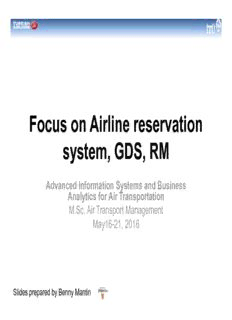
Focus on Airline reservation system, GDS, RM PDF
Preview Focus on Airline reservation system, GDS, RM
Focus on Airline reservation system, GDS, RM Advanced Information Systems and Business Analytics for Air Transportation M.Sc. Air Transport Management May16-21, 2016 Slides prepared by Benny Mantin Background Airlines need to process manifold information Route information Destinations served by an airline Aircraft information Information on the aircrafts used by an airline Schedule information Information on when the flights operated by an airline are scheduled to run Fare information Flight prices Reservation information Passenger tickets and cargo reservations 2 Background Prior to 1950 information on inventory (available seats on a flight) was published by airlines in large books, with separate books for each type of information Travel agents had to manually look through several books for booking tickets that covered multiple airlines It was impossible to get a real-time view of the inventory since airlines could synchronize data from multiple locations only once a day 3 Background 1) had to go to to buy . 2) contacted and requested a specific flight on a specific time and date. 3) Fares were the same on each flight with each airline (pre-1978). 4) Reservations staff retrieved an index-card for that specific flight from revolving tray. 5) ’s query answered based on retrieval. 6) issued and collected from 4 Brief history In 1950 introduced the first electronic reservations system, Magnetronic Reservisor. In 1964 American Airlines and IBM developed the first computerized reservation system (CRS) that would allow real- time access to all its data across all its offices and travel agents: or Semi-Automated Business Research Environment. Initially, it was used only internally and agents still had to call. The first non-North American CRS, , was developed jointly by Air France, Lufthansa, Iberia and SAS in 1987. 5 CRS Overview Storing and retrieving information and conducting air travel transactions Originally designed and operated by airlines, later extended and used by Travel Agencies Single travel providers store their reservations CRSs contain: Airline flight schedules Availability information Fare tariffs Passenger reservations, ticketing and cancellations/refund records An airline's distribution works within their own reservation system, as well as pushing out information to the GDS Airlines also manage direct distribution channels where consumers make their reservations directly with the airline (call centre, Internet) 6 Growing Pains of CRSs CRSs simplified the task of maintaining airline data, but new challenges arose: Increasing passenger traffic required larger and more expensive computer systems High cost for (smaller) airlines mainframe connectivity CRSs were airline specific Travel agencies required individual connections to airlines Travel agents had to be trained on different mainframe clients Airline CRSs Inability to perform direct searches across airline systems Combining airline inventories was a tedious process because inventory searches and reservations had to be performed in individual airline CRSs separately 7 From CRS to GDS Need to host data for more than one airline for more efficiency for growing airline industry CRSs transformed from being single airline reservation systems to multi airline Global Distribution Systems (GDSs) GDSs share data to increase efficiency Airline CRSs Synchronization link 88 GDSs Lower cost distribution From CRS to GDS Current Alternative (“hybrid”) Future Distribution System IATA’s mechanisms (providing web- NDC 2006 GDS contracts expire based visibility while “pulling inventory" from the GDS, e.g. 2005 Alternative GDS emerge, Travelocity, Expedia, Opodo) low-cost carriers 2004 GDS deregulation 2003 Growth of web-only (non-GDS) content 2001 Increasing growth of web fares; airlines begin diverting GDS 1990’s Internet emerges as direct consumer channel; GDS struggle for market shares 1980’s CRS become GDS 1970’s Travel agents use CRS 1960’s Airlines create CRS Higher cost distribution 9 Advantages of a GDS Simplified access to most airlines through one interface Ability to connect to multiple airlines either through legacy mainframe clients or PC based clients Less maintenance and up-keep overhead Ability to combine airline inventories 10
Description: